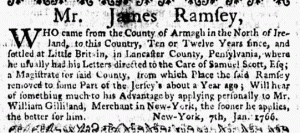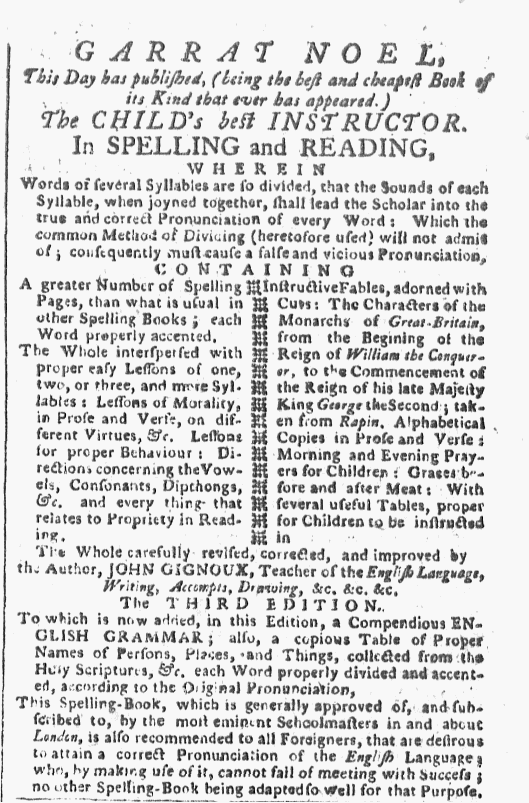GUEST CURATOR: Mary Aldrich
What was advertised in a colonial newspaper 250 years ago this week?

“Mr. James Ramsey … Will hear of something much to his Advantage.”
Mr. James Ramsey originally from the North of Ireland, who were you and what did Mr. William Gilliland want with you? Could this William Gilliland be the prosperous merchant who bought land in the Champlain Valley where he planned to build an estate and after whom the town of Willsborough is named?
I wonder what he could have wanted with James Ramsey, whom he obviously knew a deal about: where he was born, when he came to the colonies, and where he was living for a while. Yet he does not know where he went and for some reason Ramsey did not leave a forwarding address with the man whom he previously had his letters directed to, Samuel Scott, Esq. Maybe he did not want to be found by Gilliland. This advertisement is not addressed only to Ramsey but instead to the population at large, as if Gilliland is hoping that someone will see this advertisement and bring it to the attention of Ramsey.
**********
ADDITIONAL COMMENTARY: Carl Robert Keyes
This advertisement testifies to the mobility that was part of everyone’s experience in eighteenth-century America. Some colonists moved around quite regularly as they pursued opportunities to improve their lives or fled from debtors, to name just a couple of the many reasons for migration in the colonies and throughout the Atlantic world. Anyone who remained in one village, town, or city throughout his or her lifetime would have certainly witnessed others moving in, moving out, or passing through.
For instance, William Moraley migrated from England to Philadelphia and, eventually, Burlington, New Jersey, when he became an indentured servant after a series of misfortunes (some of his own making) befell him. After “earning” his freedom, he wandered around the Middle Colonies, half-heartedly seeking work, before returning to England and publishing a memoir and travelogue about his experiences.
James Ramsey also appears to have been a mobile fellow, moving from County Armagh, Northern Ireland, to Lancaster County, Pennsylvania, to an unknown location in New Jersey. Today we have many tools for locating long lost friends and relatives, but the situation was much more difficult in the eighteenth century. A newspaper advertisement like this one, an open announcement for all readers to see and pass along, would have been William Gilliland’s best option for contacting Ramsey. No newspapers were published in New Jersey in 1766, but issues printed in New York would have circulated in the colony. Again, Gilliland deployed one of the best technologies and most sophisticated methods of disseminating information available at the time, but his efforts still relied on chance.






